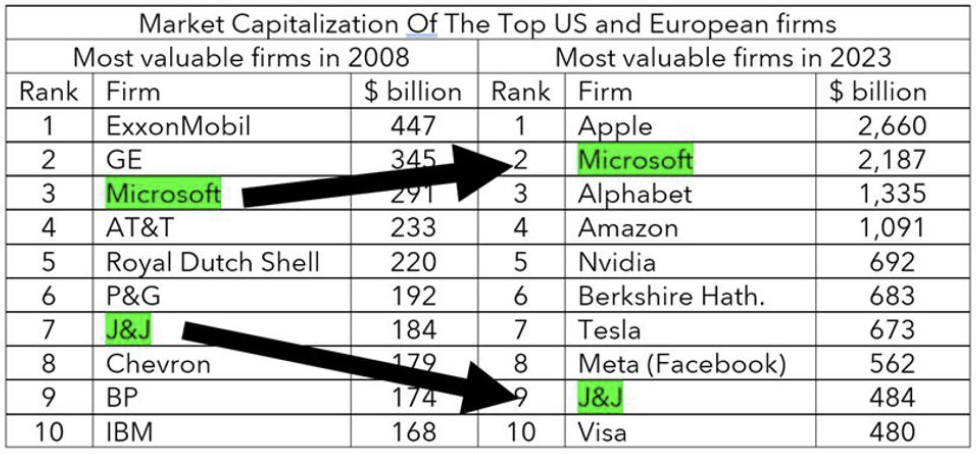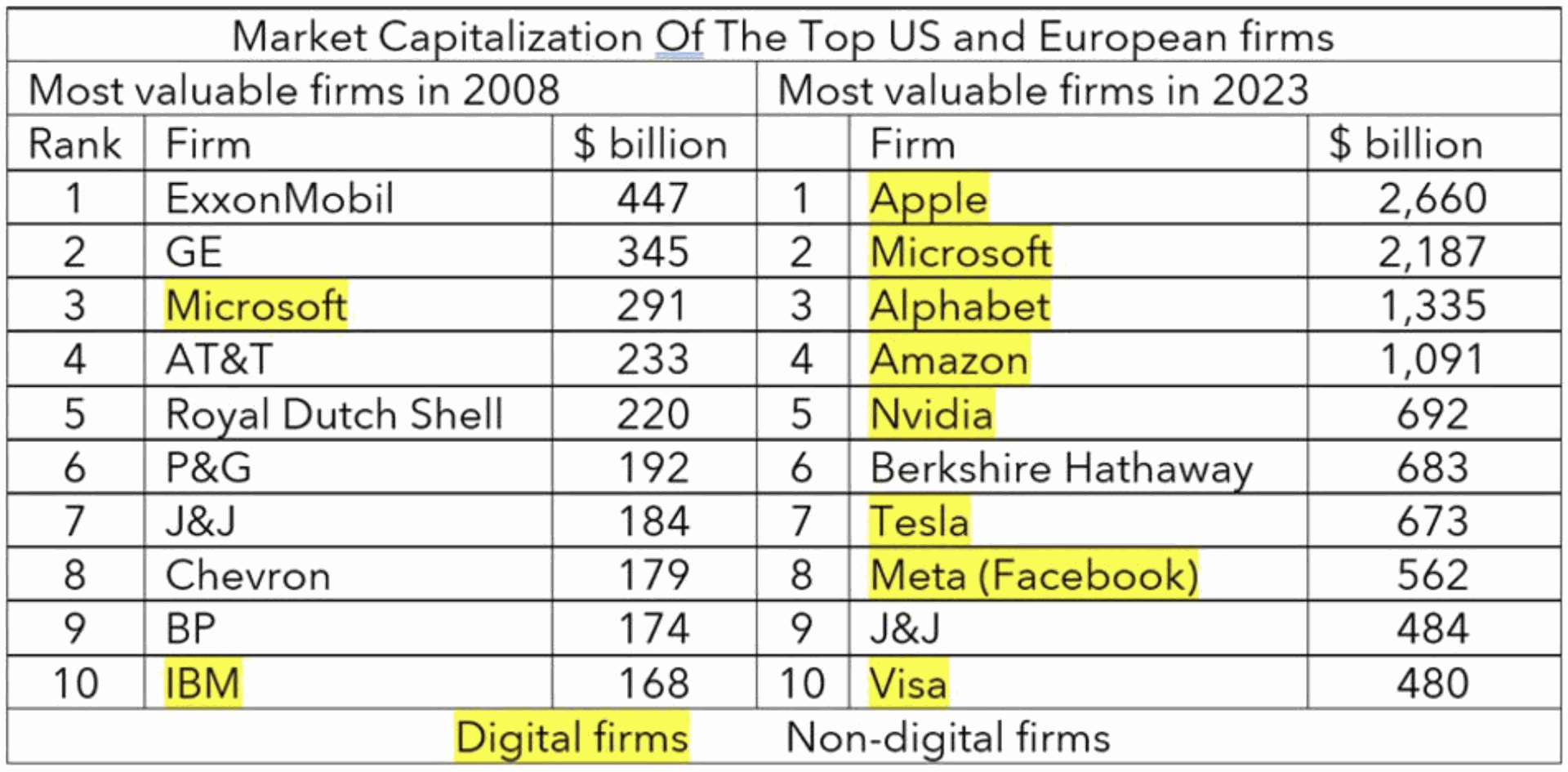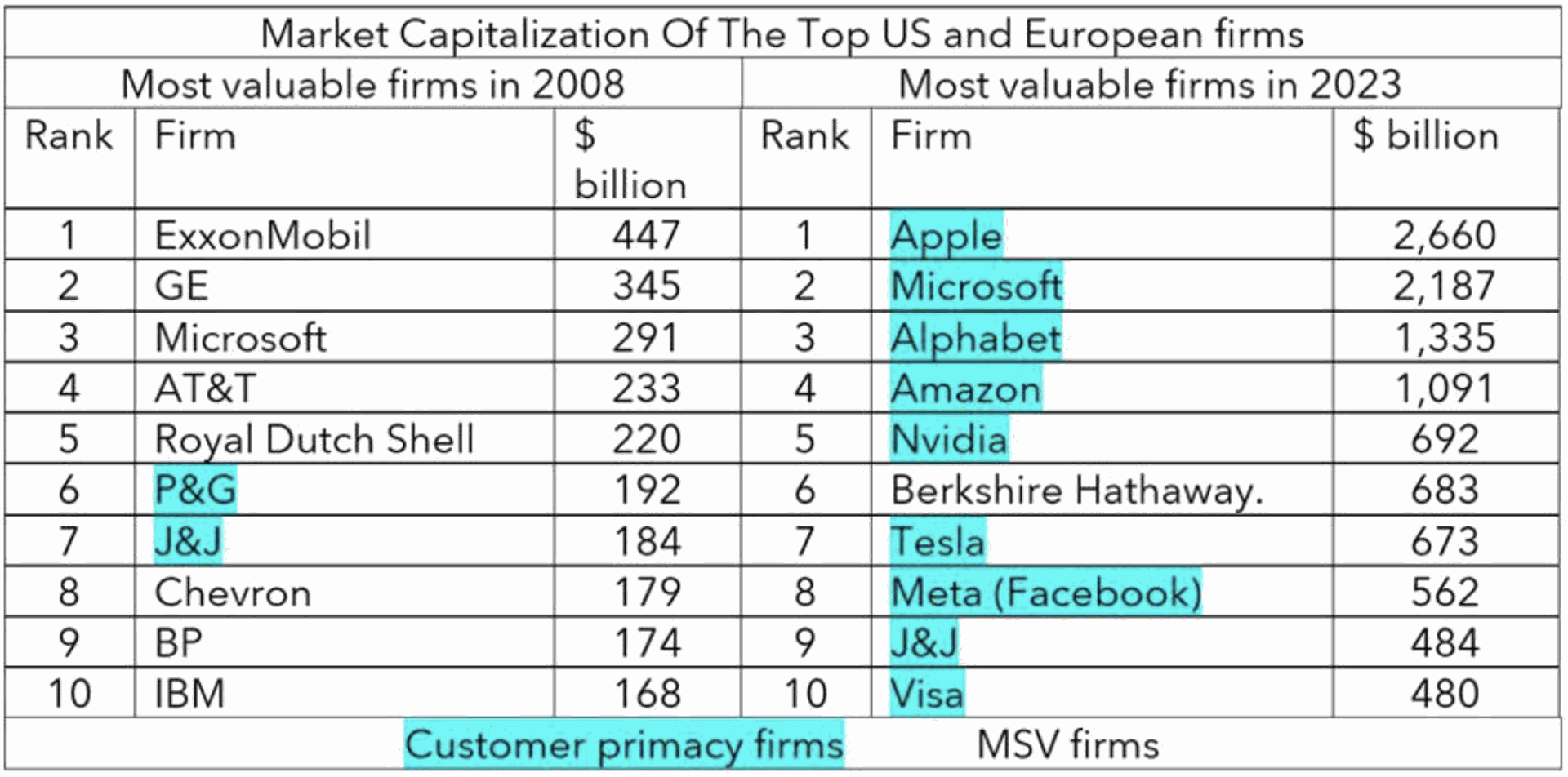As the challenge of re-imagining the concept of management re-emerges, it is instructive to learn from the 2008 ‘Moonshots For Management’—a group of 25 management scholars and senior executives, led by Gary Hamel, that set out to “define an agenda for management during the next 100 years.” The experience was documented in Harvard Business Review. Five key reasons help explain why the group missed the main changes that actually occurred to management in the next 15 years.
1. Management Headed in Unexpected Directions In Just 15 Years
After 15 years, it is obvious is that the corporate landscape has changed dramatically in directions that the Moonshots group did not expect. Of the ten most valuable firms by market capitalization in 2008, only two make the list of the ten most valuable firms in 2023. And the eight new companies are very different in kind from the industrial-era firms were the most valuable in 2008. One lesson for re-imagining management in 2023 is to expect the unexpected.

Figure 1: Only two firms made the top 10 in both 2008 and 2023
2. The Moonshots Group Missed The Significance Of Digital Technology
It is striking that in the 2008 “Moonshots for Management” article, the word, “digital”, does not appear, even once. Yet a key difference between the ten most valuable firms in 2008 and the most valuable firms in 2023 is that the latter group comprises mostly firms that have mastered the world of digital technology. In 2008, only two of the top ten firms were “digital”. By 2023, eight of the ten were discernibly “digital” firms.

Figure 2: Digital firms went from 2 in 2008 to 8 in 2023
3. The Moonshots Group Missed The Shift To Customer Primacy
Another striking fact is that in 2008, only two of the ten most valuable firms had customer-focused mission statements. The others were still mostly in the shareholder primacy mode that had been endorsed by the Business RoundTable in 1997 as the norm for big business.
By 2023, nine of the ten most valuable firms have adopted mission statements that give primacy to the customer. That is one of the ironies of the digital age: an explicit customer-focus generates more benefits for shareholders than giving management primacy to shareholder value.

Figure 3: Customer primacy firms went from 2 out of 10 in 2008 to 9 out 10 in 2023
In fact, it was Roger Martin, Dean of the Rotman School of Management at the University of Toronto, who did not participate in the “Moonshots” gathering, and who grasped that we were already living in the “The Age of Customer Capitalism” with his 2010 HBR article.
Moreover, if the Moonshots group had consulted the writings of Peter Drucker, they would have been reminded what Drucker had insisted on, ever since 1954: “There is only one valid purpose of a corporation: to create a customer.” Another lesson for re-imagining management in 2023 is that key insights may come from very old sources, not necessarily the “next new thing.”
The failure of the Moonshots group to grasp the central role of the customer in corporate purpose is related to their missing the significance of digital technology. That’s because digital technology enables the achievement of an almost infinite set of possibilities. Success in its use requires narrowing the focus to those possibilities that create value to customers. Otherwise, firms will waste time and money on many things that customers don’t want or need. A tight focus on the customer is required if a firm is to make money from the technology.
The Moonshots group was less concerned about making money than about “the achievement of noble, socially significant goals,” perhaps overlooking the fact that unless a firm makes money, it will not be around to pursue such goals. It will have gone bankrupt.
4. The Moonshot Group Missed The Shift To Decentralized Decision-making
The Moonshots group also missed the shift toward decentralized decision-making that Rita McGrath has noted in her January 2023 article on “The Permissionless Corporation,” “Digital technologies,” McGrath wrote, “are pushing decision-making ability to the edges of the organization, allowing businesses to adopt structures that are flatter and more reconfigurable than those they have traditionally used.”
Yet this was not truly news, even in 2008. If the Moonshots group had paid attention to the findings of business school professors, Larry Selden and Ian MacMillan, with their 2006 article, “Manage Customer-Centric Innovation—Systematically” they would have learned that successful continuing innovation requires propelling “the innovation effort away from headquarters and the traditional R&D lab out to those closest to the customer.”
Moreover, if the Moonshots group taken notice that the Agile movement, which had been founded in 2001 and was already flourishing by 2008, was essentially a recognition that top-down decision making didn’t work in using digital technology: decision making had to be pushed to the front lines where the action was happening. The shift was not something that management welcomed: it was often traumatic for managers to discover that their future resided in the hieroglyphics of computer coding. Thus, the shift towards decentralized decision-making was less a management decision than an inexorable necessity, given the nature of digital technology. As the Moonshot group wasn’t thinking much about technology, it missed the significance.
5. The Moonshot Group Missed That Technology Drives Management, Not Vice Versa
The Moonshot article mentioned “the primacy of shareholder interests” as one of several “principles of the industrial-age paradigm” that needed to be replaced. But their conclusions failed to identify a viable alternative in terms of the firm’s goal.
Instead, as the title of the article suggests, the solution was expected to come from “moonshots,” that is to say, as if from another planet. Thus according to the article, “the scholars and practitioners must rebuild management’s underpinnings. That will require hunting for new principles in fields as diverse as anthropology, biology, design, political science, urban planning, and theology.”
The word “technology” occurs only three times in the Moonshot article, and two of those references are a passing reference to management itself as a kind of technology. The group appears to have missed the central role of technology in driving change in management, rather than the principles of “anthropology, biology, design, political science, urban planning, and theology.”
One lesson for current efforts to re-imagine management is to pay particular attention to technology, particularly technology that is already being implemented but is still at an early stage. Technologies like artificial intelligence are already making waves in 2023 among the current most-valuable firms, which are investing heavily in it. They are likely to have a significant impact on management in the future.
“We are living, says Microsoft CEO Satya Nadella, “through a generational shift in our economy and society. Digital technology is the most malleable resource at the world's disposal to overcome constraints and re-imagine everyday work and life. As every company becomes a digital company, they need a distributed computing fabric to build, manage, secure and deploy applications anywhere.”
This article was written by Steve Denning to Forbes, on April 2nd of 2023. You can find the original article here.